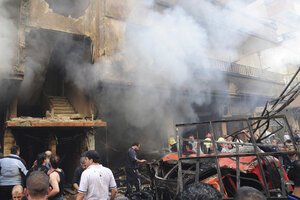Airstrikes, car bombs in Syria leave brief cease-fire in tatters
Estimates say at least 110 people were killed on Sunday in fighting between rebels and regime forces, with both sides accusing the other of having broken the UN-brokered cease-fire.

In this photo released by the Syrian official news agency SANA, Syrian citizens gather in front of a damaged building that was destroyed by a car bomb, at Jaramana neighborhood, in Damascus, Syria, Monday Oct. 29, 2012. A Syrian government official says a car bomb in a Damascus suburb has killed 10 people.
SANA/AP
• A daily summary of global reports on security issues.
Syrian opposition activists report that jets fired on several spots throughout the country yesterday, signaling decisively the demise of a United Nations-brokered cease-fire, which was broken by skirmishes almost as soon as it began last week.
Both sides have repeatedly broken the agreement since it began, with the government placing the blame on "terrorists" and the rebels saying they couldn't trust President Bashar al-Assad to uphold the cease-fire while his troops continued to stage strikes throughout the country. Reuters writes:
Syrian authorities blame "terrorists" for breaking the truce and the opposition says a ceasefire is impossible while Assad moves tanks and uses artillery and jets against populated areas.
A statement by the Syrian military said "blatant" rebel violations proved they want to "fragment and destroy Syria".
"These terrorist groups must be confronted, their remnants chased and an iron fist used to exterminate them and save the homeland from their evil," the statement said.
Reuters adds that in Damascus, residents reported bombings in several suburbs, as well as two car bombs. There were also air strikes in the provinces of Deir al-Zour, Idlib, and Aleppo, the latter two of which are mostly under rebel control on the ground. Activists also reported fighting in the city of Aleppo.
The BBC reports that according to the Britain-based Syrian Observatory for Human Rights, an opposition activist group, at least 110 people were killed yesterday alone, the third day of the cease-fire – 39 civilians, 34 rebel fighters, and 35 government security forces.
The Telegraph reports that death estimates for the second day of the cease-fire were somewhere between 91 and 114 – far lower than at the height of fighting, but still not a good sign for the chances of an extension of the break in fighting.
Lakhdar Brahimi, the UN special envoy to Syria who brokered the agreement, is expected to reopen talks at the UN Security Council, which backed the cease-fire. However, it is unclear what options he is left with after both the government and the rebels made it clear there would be no total compliance with this agreement.
Page Fortna, a Columbia University political science professor who has authored books on peacekeeping and cease-fires, wrote presciently in Foreign Policy in the early hours of the agreement that "a few days of relief" will be useful and that there was the possibility of an agreement helping to build "a sliver of trust momentum toward a permanent end," but the factors working against that are myriad in a temporary cease-fire.
All cease-fires are fragile, but temporary ones face a structural problem that makes them more fragile than most. As the end of the ceasefire period nears, there is an incentive to go on the offensive prior to the expiration date in order to gain an advantage over the other side. The other side is aware of this, however, and has an equal incentive to move against its adversaries, who, in turn, know this, and so have an incentive to attack even sooner, and so on and so forth. Not surprisingly, temporary ceasefires with a fixed expiration have a tendency to unravel.
This problem can be mitigated if both sides know that it would be clear who broke the ceasefire first – provided there are real costs to doing so.
…
But this is a do-it-yourself ceasefire – there will be no monitors to observe compliance, since the UN withdrew its observer mission over the summer. As a result, if fighting resumes, it will be difficult for outsiders to tell who started what. The military incentives to strike first, coupled with plausible deniability, thus make it less likely that the truce will hold through the holiday weekend.
Professor Fortna warns that the more times mediation attempts fail, the higher the hurdles to peace become each time around. The best way to make a cease-fire durable is to put peacekeepers on the ground to hold accountable whoever breaks the agreement first.
The UN has already set in motion another attempt at a monitoring mission; the last one was called off because the violence became too great for them to work.
Fortna writes:
Peacekeeping missions are notoriously dysfunctional – chronically underfunded and underequipped; they tend to arrive late and are plagued by force interoperability problems. And yet, they are surprisingly effective. Why is this so? Impartial observers make it more costly to violate the terms of a ceasefire (or a more comprehensive peace deal) by providing information to the international community about who is or is not living up to commitments. They also provide the same information to the local population. So to the extent that the parties are vying for both international and domestic legitimacy, their presence makes returning to war more costly and maintaining a ceasefire more likely.

